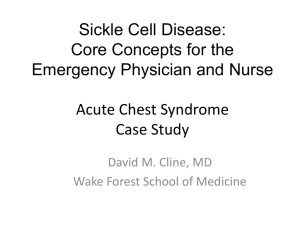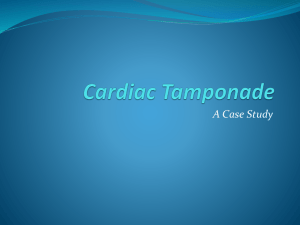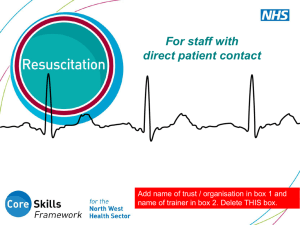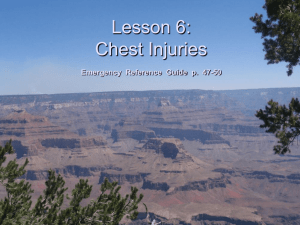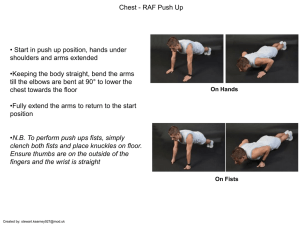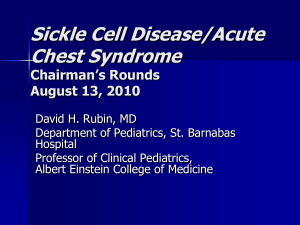Acute Chest Syndrome - Emergency Department Sickle Cell
advertisement
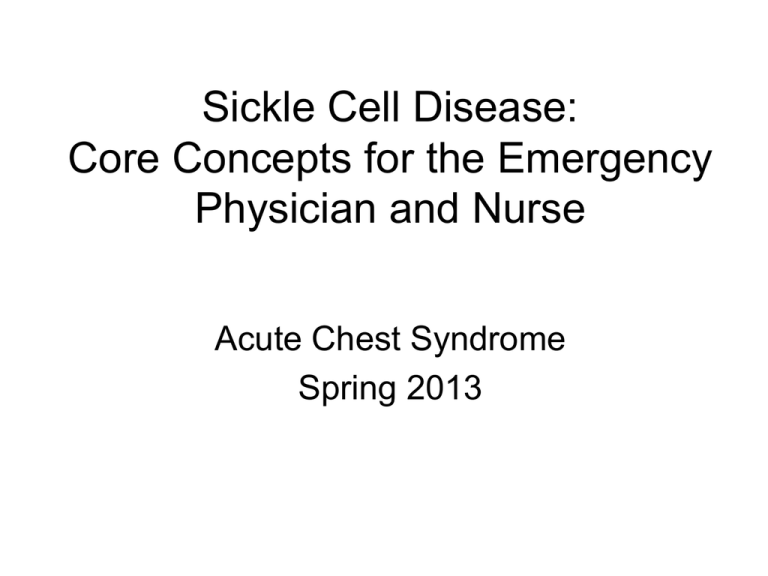
Sickle Cell Disease: Core Concepts for the Emergency Physician and Nurse Acute Chest Syndrome Spring 2013 Acute Chest Syndrome A life-threatening complication of sickle cell disease. The most common cause of premature death in patients with sickle cell disease. Definition; causes; risks A new pulmonary infiltrate with some combination of fever, chest pain, and signs and symptoms of pulmonary diseases such as tachypnea, cough, and dyspnea. The cause of most cases of acute chest syndrome is unknown, but infection (both bacteria and viruses) and pulmonary infarction are believed to play the most important roles. Risk factors include: increasing age, asthma, smoking, recent surgery, chronic hypoxia, SS disease, and other genetic factors. Signs and Symptoms Fever, cough, chest pain, shortness of breath, chills, wheezing, and hemoptysis. Children are more likely to present with fever and cough. Adults are more likely to present with chest pain, shortness of breath, productive cough, hypoxia, and hemoptysis. Chest, rib, and extremity pain are more common in adults. Radiography 61% of cases are not suspected prior to the chest x-ray results. ACS and associated infiltrates may not appear until 2-3 days after initial presentation. Acute chest syndrome frequently develops after admission for uncomplicated vaso-occlusive crisis. Incentive spirometry can be used to prevent acute chest. Chest x-ray underestimates the degree of pulmonary involvement. Hematologic Findings Typically, hemoglobin drops 0.7 g/dl Typically, white blood cell counts increases by 69%, accompanied by increased reticulocyte count. These changes do not distinguish this complication from simple vaso-occlusive crisis. 70% of the patients are hypoxemic during the course of the illness (oxygen saturation by pulse oximetry of less than 90%), but may not be hypoxic at the time of initial presentation. Treatment: Acute Chest Syndrome Monitor oxygenation with pulse oximetry; give supplemental oxygen to maintain SpO2 ≥ 95% Pain management Empiric antibiotic coverage Consult hematology Blood transfusion of exchange transfusion may be needed in as many as ¾ of cases Treatment: Pain and Hydration Pain management using adequate opiate analgesia helps to prevent hypoventilation Intercostal nerve blocks should be considered if chest pain is marked and sedation limits opiate use. Overhydration or excessive opiate use may worsen acute chest syndrome. Patient-controlled analgesia may help to limit sedation from opiate analgesia. Transfusion and Antibiotics Consult Hematology for possible transfusion Give simple blood transfusion (10 mL/kg red blood cells) to improve oxygen carrying capacity to people with symptomatic ACS and a hemoglobin concentration ≥ 1 gm/dl below baseline. If baseline hemoglobin is 9 gm/dl or higher, simple blood transfusion may not be required. Perform urgent exchange transfusion with consultation from hematology/ critical care and/or apheresis specialist in people with ACS whose oxygen saturation is below 90 percent despite supplemental oxygen, and/or with increasing respiratory distress, progressive pulmonary infiltrates, decline in hemoglobin concentration, or rapid progression of symptoms. For antibiotic coverage, use a third or fourth generation cephalosporin plus a macrolide IV. Alter coverage depending on local bacterial patterns, resistance and allergy history. Complications Pulmonary embolism /deep vein thrombosis Acute pulmonary hypertension Respiratory failure Neurologic events including stroke Sepsis Obstructive and restrictive pulmonary dysfunction Acute kidney injury Overall the death rate is 3%, but the death rate is 9% in adult patients. Summary ACS is life-threatening Patients complain of chest pain and pulmonary symptoms, but the syndrome may follow a vaso-occlusive pain crisis. Patients are treated with oxygen, careful pain management, careful hydration, antibiotics, and blood transfusion as needed to reverse hypoxia. Patients should be carefully monitored and treated for any complications that arise. Post Test 1. Which of the following statement concerning Acute Chest Syndrome are false: A. Risk factors include among other factors: increasing age, asthma, smoking, recent surgery, chronic hypoxia, and SS disease. B. Acute chest syndrome is defined as: a new pulmonary infiltrate with some combination of fever, chest pain, hypoxia, and signs and symptoms of pulmonary diseases such as tachypnea, cough, and dyspnea. C. The cause of acute chest syndrome is usually bacterial pneumonia and should be treated as a simple pneumonia. D. Acute chest syndrome frequently develops after hospital admission for uncomplicated vaso-occlusive crisis. Post Test 2. Which of the following statements concerning Acute Chest Syndrome is true: A. Infiltrates on chest x-ray are always present at the time of admission to the hospital. B. Over hydration or excessive opiate use is rarely a problem in this disorder. C. Exchange transfusion is indicated if any of the following are present: 1. saturation is below 90 percent despite supplemental oxygen, 2. increasing respiratory distress, 3. progressive pulmonary infiltrates, 4. decline in hemoglobin concentration, or rapid progression of symptoms. D. The death rate for this disorder is less than 1%. Post Test Answers 1. The answer is C. “The cause of acute chest syndrome is usually bacterial pneumonia and should be treated as a simple pneumonia.” This is the only false statement. • While antibiotics are part of the treatment of acute chest syndrome, bacterial pathogens are frequently not recovered from cultures, and unlike the treatment for simple pneumonia, transfusion is frequently needed and can be life saving. 2. The correct answer is C, which lists the correct indications for exchange transfusion for the patient with acute chest syndrome. • Answer A is not correct because infiltrates may not appear until 2-3 days after initial presentation and admission to the hospital. • Answer B is not correct because over-hydration or excessive opiate use has been shown to worsen the course of patients with acute chest syndrome by increasing hypoxia. • Answer D is not correct because the death rate is 3% in all patients including children, but the death rate is 9% in adult patients.
